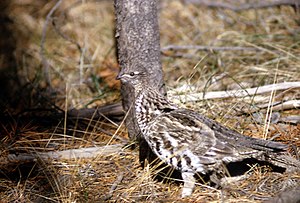Difference between revisions of "Field Guide/Birds/Bonasa umbellus"
(wiki fr) |
m (- Category of AYHAB) |
||
| (58 intermediate revisions by 19 users not shown) | |||
| Line 1: | Line 1: | ||
| − | {{ | + | {{Bird_id |
| − | + | | name = Ruffed Grouse | |
| − | + | | latin_name = Bonasa umbellus | |
| − | + | | level = 4 | |
| − | + | | image_1 = Ruffed grouse NPS.jpg | |
| − | + | | caption_1 = Ruffed Grouse | |
| − | + | | description = The '''Ruffed Grouse''', ''Bonasa umbellus'', is a medium-sized grouse occurring in forests across Canada and the Appalachian and northern United States including Alaska. They are non-migratory. | |
| − | |||
| − | |||
| − | |||
| − | |||
| − | |||
| − | |||
| − | + | Ruffed Grouse have two distinct color phases, grey and red. In the grey phase, adults have a long square brownish tail with barring and a black subterminal band near the end. The head, neck and back are grey-brown; they have a light breast with barring. The ruffs are located on the sides of the neck. These birds also have a "crest" on top of their head, which sometimes lays flat. Both sexes are similarly marked and sized, making them difficult to tell apart, even in hand. The female often has a broken subterminal tail band, while males often have unbroken tail bands. Another fairly accurate method for sexing ruffed grouse involves inspection of the rump feathers. Feathers with a single white dot indicate a female, feathers with more than one white dot indicate that the bird is a male. | |
| − | Ruffed Grouse have | + | Ruffed Grouse have never been successfully bred in captivity. |
| − | + | These birds forage on the ground or in trees. They are omnivores, eating buds, leaves, berries, seeds, and insects. | |
| − | + | The male is often heard drumming on a fallen log in spring to attract females for mating. Females nest on the ground, typically laying 6-8 eggs. Grouse spend most of their time on the ground, and when surprised, may explode into flight, beating their wings very loudly. | |
| − | + | }} | |
| − | |||
| − | |||
| − | |||
| − | |||
| − | |||
| − | |||
| − | |||
| − | |||
| − | |||
| − | |||
| − | |||
| − | |||
| − | |||
| − | |||
| − | |||
| − | |||
Latest revision as of 00:41, 15 July 2022
| Bonasa umbellus (Ruffed Grouse) | |
|---|---|
| Description | |
| The Ruffed Grouse, Bonasa umbellus, is a medium-sized grouse occurring in forests across Canada and the Appalachian and northern United States including Alaska. They are non-migratory.
Ruffed Grouse have two distinct color phases, grey and red. In the grey phase, adults have a long square brownish tail with barring and a black subterminal band near the end. The head, neck and back are grey-brown; they have a light breast with barring. The ruffs are located on the sides of the neck. These birds also have a "crest" on top of their head, which sometimes lays flat. Both sexes are similarly marked and sized, making them difficult to tell apart, even in hand. The female often has a broken subterminal tail band, while males often have unbroken tail bands. Another fairly accurate method for sexing ruffed grouse involves inspection of the rump feathers. Feathers with a single white dot indicate a female, feathers with more than one white dot indicate that the bird is a male. Ruffed Grouse have never been successfully bred in captivity. These birds forage on the ground or in trees. They are omnivores, eating buds, leaves, berries, seeds, and insects. The male is often heard drumming on a fallen log in spring to attract females for mating. Females nest on the ground, typically laying 6-8 eggs. Grouse spend most of their time on the ground, and when surprised, may explode into flight, beating their wings very loudly. | |

